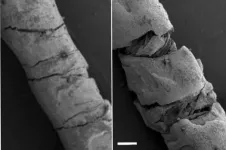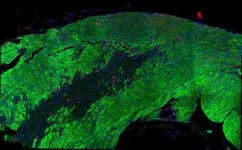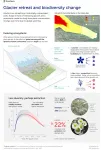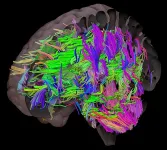(Press-News.org) Engineers at Tufts University have created and demonstrated flexible thread-based sensors that can measure movement of the neck, providing data on the direction, angle of rotation and degree of displacement of the head. The discovery raises the potential for thin, inconspicuous tatoo-like patches that could, according to the Tufts team, measure athletic performance, monitor worker or driver fatigue, assist with physical therapy, enhance virtual reality games and systems, and improve computer generated imagery in cinematography. The technology, described today in Scientific Reports, adds to a growing number of thread-based sensors developed by Tufts engineers that can be woven into textiles, measuring gases and chemicals in the environment or metabolites in sweat.
In their experiments, the researchers placed two threads in an "X" pattern on the back of a subject's neck. Coated with an electrically conducting carbon-based ink, the sensors detect motion when the threads bend, creating strain that changes the way they conduct electricity. When the subject performed a series of head movements, the wires sent signals to a small Bluetooth module, which then transmitted data wirelessly to a computer or smartphone for analysis.
The data analysis involved sophisticated machine learning approaches to interpret the signals and translate them to quantitate head movements in real time, with 93% accuracy. In this way, the sensors and processor track motion without interference from wires, bulky devices, or limiting conditions such as the use of cameras, or confinement to a room or lab space.
While algorithms will need to be specialized for each location on the body, the proof of principle demonstrates that thread sensors could be used to measure movement in other limbs, according to the researchers. The skin patches or even form-fitting clothing containing the threads could be used to track movement in settings where the measurements are most relelvant, such as in the field, the workplace, or a classroom. The fact that a camera is not needed provides for additional privacy.
"This is a promising demonstration of how we could make sensors that monitor our health, performance, and environment in a non-intrusive way," said Yiwen Jiang, an undergraduate student at Tufts University School of Engineering and first author of the study. "More work needs to be done to improve the sensors' scope and precision, which in this case could mean gathering data from a larger array of threads regularly spaced or arranged in a pattern, and developing algorithms that improve the quantification of articulated movement."
Other types of wearable motion sensor designs have included 3-axis gyroscopes, accelerometers and magnetometers to detect movement of the subject in relation to their surroundings. Those sensors are based on inertial measurements - quantifying how the body accelerates, rotates or moves up and down -and tend to be bulkier and more inconvenient. For example, with other systems, in order to measure head movement, it is necessary to place one sensor on the forehead and another on the neck above the vertebrae. The obtrusive placement of equipment can interfere with the subjects' free movement or simply the convenience of not being conscious of being measured.
For situations such as on the athletic field, the novel thread-based sensor paradigm could be a game changer. By placing thin tatoo-like patches on different joints, an athlete could carry motion sensors to detect their physical movement and form, while thread-based sweat sensors, described in earlier work by the Tufts team, could also potentially track their electrolytes, lactate and other biological markers of performance in sweat.
On the road, a thread sensor patch could alert to truck driver fatigue or other situations where tracking operator alertness is critical, monitoring the head movements of someone about to nod off.
"If we can take this technology further, there could be a wide range of applications in healthcare as well," said Jiang. "For example, those researching Parkinson's disease and other neuromuscular diseases could also track movements of subjects in their normal settings and daily lives to gather data on their condition and the effectiveness of treatments."
"The objective in creating thread-based sensors is to make them 'disappear' as far as the person wearing them is concerned," said Sameer Sonkusale, professor of electrical and computer engineering at Tufts' School of Engineering, director of the Tufts Nanolab, and corresponding author of the study. "Creating a coated thread capable of measuring movement is a remarkable achievement, made even more notable by the fact that Yiwen developed this invention as an undergraduate. We look forward to refining the technology and exploring its many possibilities."
INFORMATION:
Researchers from the Hubrecht Institute mapped the recovery of the heart after a heart attack with great detail. They found that heart muscle cells - also called cardiomyocytes - play an important role in the intracellular communication after a heart attack. The researchers documented their findings in a database that is accessible for scientists around the world. This brings the research field a step closer to the development of therapies for improved recovery after heart injury. The results were published in Communications Biology on the 29th of January.
In the Netherlands, an average of 95 people end up in the hospital each day ...
Efforts to understand when corals reproduce have been given a boost thanks to a new resource that gives scientists open access to more than forty years' worth of information about coral spawning.
Led by researchers at Newcastle University, UK, and James Cook University, Australia, the Coral Spawning Database (CSD) for the first time collates vital information about the timing and geographical variation of coral spawning. This was a huge international effort that includes over 90 authors from 60 institutions in 20 countries.
The data can be used by scientists and conservationists to better understand the environmental cues that influence when coral ...
(Singapore--16:45 p.m. SPT/3:45 EST January 29, 2021)--Two presentations from the ADAURA clinical trial advanced previous research that demonstrated improved disease-fee survival (DFS) outcomes for patients with surgically resected non-small cell lung cancer (NSCLC) receiving osimertinib. The data were reported today at the International Association for the Study of Lung Cancer's 2020 World Conference on Lung Cancer (WCLC) Singapore.
Osimertinib is a third-generation, irreversible, central nervous system-active, epidermal growth factor receptor (EGFR)-tyrosine kinase inhibitor. ADAURA is a randomized Phase III trial comparing adjuvant osimertinib with placebo in patients ...
Beyond the ski slopes, one of the most iconic symbols of the Alps are the alpine flowers. These plants are not only beautiful -- they are also used in liqueurs and medicines, and they form the foundation of the local food chains. But a recent study in Frontiers in Ecology and Evolution shows that, although plant diversity may initially increase with glacier retreat, many of these species may soon become endangered.
"Our results indicate that plant diversity will ultimately decrease once the glaciers disappear -- and up to 22% of the species we analyzed may locally disappear or even go extinct once the glaciers are gone," says lead author Dr Gianalberto Losapio of Stanford University in the USA. "We show that 'not all species are equal before global warming' and that there are some species ...
Methane (CH4) is the second most important greenhouse gas after carbon dioxide (CO2). Its concentration in the atmosphere has increased more than twice since the preindustrial era due to enhanced emissions from human activities. While the global warming potential of CH4 is 86 times as large as that of CO2 over 20 years, it stays in the atmosphere for about 10 years, much shorter than more than centuries of CO2. It is therefore expected that emission controlling of CH4 can benefit for relatively short time period toward the Paris Agreement target to limit the global warming well below 2 degrees.
A study by an international team, published ...
New research from the University of Sheffield has found being overweight is an additional burden on brain health and it may exacerbate Alzheimer's disease.
The pioneering multimodal neuroimaging study revealed obesity may contribute toward neural tissue vulnerability, whilst maintaining a healthy weight in mild Alzheimer's disease dementia could help to preserve brain structure.
The findings, published in The Journal of Alzheimer's Disease Reports, also highlight the impact being overweight in mid-life could have on brain health in older age.
Lead author of the study, Professor Annalena Venneri from the University of Sheffield's Neuroscience Institute and NIHR Sheffield Biomedical Research Centre, ...
Four million UK patients could benefit annually from genetic testing before being prescribed common medicines, according to new research from the University of East Anglia (UEA) in collaboration with Boots UK and Leiden University (Netherlands).
Researchers looked through 2019 NHS dispensing data across the UK to see how many patients are started on new prescriptions each year that could be potentially optimised by genetic testing.
They studied 56 medicines, including antidepressants, antibiotics, stomach ulcer treatments and painkillers where there are known drug-gene interactions.
And they found that in more than one in five occasions (21.1 ...
An interdisciplinary team of the Institut national de la recherche scientifique (INRS) used an innovative imaging technique for a better understanding of motor deficits in Amyotrophic Lateral Sclerosis (ALS). The researchers were able to follow the escape behaviour of normal and disease zebrafish models, in 3D. Their results have recently been published in Optica, the flagship journal of the Optical Society (OSA).
Professor Jinyang Liang, expert in ultra-fast imaging and biophotonics, joined an effort with Professor Kessen Patten, specialist in genetics and neurodegenerative diseases. The two groups were able to track the position of ...
New research from the University of Iowa and University Hospitals Cleveland Medical Center demonstrates that offspring can be protected from the effects of prenatal stress by administering a neuroprotective compound during pregnancy.
Working in a mouse model, Rachel Schroeder, a student in the UI Interdisciplinary Graduate Program in Neuroscience, drew a connection between the work of her two mentors, Hanna Stevens, MD, PhD, UI associate professor of psychiatry and Ida P. Haller Chair of Child and Adolescent Psychiatry, and Andrew A. Pieper, MD, PhD, a former UI faculty member, now Morley-Mather Chair of Neuropsychiatry at Case Western Reserve ...
-- Experts call for policy reform to improve ethnic equity of socioeconomic opportunity, service provision, and health outcomes. They also call for long-term studies to investigate how structural and institutional racism generate these ethnic inequalities in health.
In 15 out of 17 minority ethnic groups, health-related quality of life in older age (over 55 year-olds) was worse on average for either men, women, or both, than for White British people according to an observational study published in The Lancet Public Health journal.
In five of those groups - Bangladeshi, Pakistani, ...






